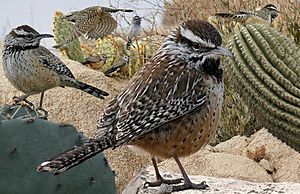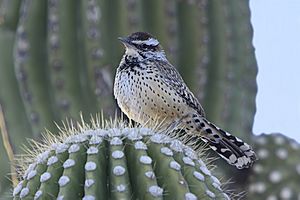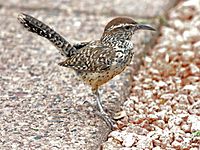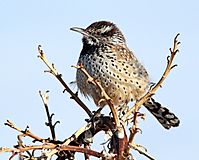Cactus wren facts for kids
Quick facts for kids Cactus wren |
|
|---|---|
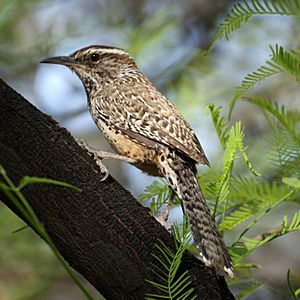 |
|
| Adult perched in a honey mesquite tree | |
| Conservation status | |
| Scientific classification | |
| Genus: |
Campylorhynchus
|
| Species: |
brunneicapillus
|
|
|
 |
|
| Range map of the cactus wren | |
| Synonyms | |
|
|
The cactus wren (Campylorhynchus brunneicapillus) is a special type of wren bird. It lives only in the deserts of the southwestern United States and northern and central Mexico. It is the official state bird of Arizona. It is also the biggest wren found in the United States!
This bird has brown feathers with black and white spots. It has a clear white "eyebrow" that goes back to its neck. Its chest is white, and its belly is a warm cinnamon-buff color. Both male and female cactus wrens look alike. Their tail and flight feathers have black and white stripes. Their song is a loud, scratchy chirrup. Some bird experts say it sounds like a car engine trying to start.
Cactus wrens are great at living in the desert. They get all the water they need from their food. They mostly eat insects, but also some plants. These birds are not strong fliers. They usually look for food on the ground. Bird experts recognize seven different types, or subspecies, of the cactus wren.
Its name comes from how often it uses desert cactus plants. They build nests, rest, and hide from predators among plants like the saguaro and cholla. Their nests are big and round, made of plants and lined with feathers. Cactus wrens do not migrate. They stay in their home territories all year. They live in pairs or family groups. Males build nests, females lay eggs, and both parents feed the young.
The number of cactus wrens has gone down because of human activities and habitat loss. However, there are still millions of them. The International Union for the Conservation of Nature says the cactus wren is a species of least concern.
Contents
What is a Cactus Wren?
The wren family is a group of small passerine birds. Most wrens live in North and South America. The cactus wren is the largest wren in the U.S. Globally, the giant wren and bicolored wren are similar in size. Scientists once thought the cactus wren was the same species as the Yucatan wren and Boucard's wren. But studies show they are different.
Scientists believe the cactus wren first appeared in central Mexico. This was about one million years ago. Then, it quickly spread to where it lives today.
The first time a cactus wren was officially described was in 1835. A French bird expert named Frédéric de Lafresnaye did this. He got a specimen from a naval officer who had been to California. The bird was likely from Guaymas, Mexico. But Lafresnaye thought it might be from Peru. This caused a lot of confusion for many years. Other experts described the same bird as different species.
The name Campylorhynchus is Greek. It means 'curved beak'. The second part of its scientific name, brunneicapillus, means 'brown hair'. This refers to the bird's brown head and back. The common name "cactus wren" comes from its habit of using cacti for nests and protection.
Types of Cactus Wrens
Scientists have described several types of cactus wrens. Seven are generally recognized. The exact classification is still debated. Here are some of the proposed types:
- C. b. brunneicapillus (Lafresnaye, 1835) – This is the original type. It lives in northern Mexico. It has a pure white chin.
- C. b. guttatus (Gould, 1836) – Found in central and southern Mexico. It is duller and grayer than the original type. Guttatus means 'speckled'.
- C. b. affinis (Xántus, 1860) – Lives in southern Baja California. It has lighter underparts and fewer black marks. Its tail feathers have white stripes. This type usually lays fewer eggs, often two instead of three to five.
- C. b. couesi (Sharpe, 1882) – This type covers most of the cactus wren's range in the U.S. This includes Nevada, Utah, Arizona, New Mexico, and Texas. It is larger than the original type. This type is named after army surgeon and bird expert Elliott Coues.
- C. b. bryanti (Anthony, 1894) – Found along the western coast of Baja California. It has clear white marks on its rump and shoulder feathers. Its upper parts are darker brown. It is named after bird expert Walter Pierce Bryant.
- C. b. purus (Van Rossem, 1930) – Found on the eastern and western coasts of Baja California. Its underparts are almost pure white. This type is not widely recognized. Purus means 'pure' or 'clean'.
- C. b. seri (Van Rossem, 1932) – Lives only on Tiburón Island in the Gulf of California. Its belly spots are wider.
- C. b. sandiegensis (Rea, 1986) – Found in Baja California and southern California. Some experts do not accept this as a separate type. It is named after the city of San Diego.
What Does a Cactus Wren Look Like?
The cactus wren is the biggest wren in the United States. It is about 18 to 19 centimeters (7 to 7.5 inches) long. It weighs about 33 to 47 grams (1.2 to 1.7 ounces). It has a thick, dark bill that curves slightly down. Its tail is long and rounded.
The bird's body is brown with white spots. Its head is chocolate-brown with a reddish tint. A clear white stripe, like an eyebrow, goes from its beak to the back of its neck. Its chin is white. The neck has black marks on a white background. The chest is white with brown or black spots. The belly is mostly white with some streaks. The lower belly and sides are cinnamon-buff colored.
Its main flight feathers are striped. They alternate between black and off-white. Its tail feathers are striped with brownish-black and pale gray-brown. The outer tail feathers have white tips. When it flies, you can see a white band under its tail. Its legs are brown to pink-brown.
Male and female cactus wrens look the same. Young wrens are paler. Their eyes are red-brown to muddy-gray. Adult wrens have more red-brown to red eyes. Young birds also do not have the white neck stripe. Their chest marks are less noticeable.
The desert sun and prickly plants can damage their feathers. They replace old feathers by molting from July to October. This usually happens in their own territory.
Cactus wrens look like other wrens in their group. But they live in different places. This makes them easier to identify. The white tail band seen during flight is a key feature.
What Sounds Do They Make?
The main call of the cactus wren is a harsh, scratchy sound. It sounds like "jar-jar-jar" or "char." The sound gets louder and higher as the call continues. Each call lasts about four seconds. There are four to eight seconds between calls. Their calls can be heard up to 300 meters (1,000 feet) away. Experts at Cornell University say it sounds "like a car that just won't start."
Males sing the most. Females can also sing, but their song is weaker and higher. Males start singing before sunrise. They like to sing from high places. These include trees, telephone poles, tall cacti, or roofs.
Cactus wrens have at least eight other calls.
- A "buzz" or "tek" is a warning call.
- "Growls" are used for mating and identifying each other.
- "Rack" calls help them find their mate or other wrens. This is often the first sound they make when leaving the nest.
- A high-pitched "squeal" is rare. It is only heard during nest building.
- "Scri" notes are used during fights over territory.
- Chicks make begging sounds, like a soft "peep."
- Young birds that have just left the nest make a "dzip" call.
When they make their main call, their beak is held slightly up. The feathers on their throat noticeably stick out and vibrate.
Where Do Cactus Wrens Live?

The cactus wren lives in dry and semi-desert areas. It needs spiny cacti to build its nests. Its home includes the Sonoran and Chihuahuan Deserts.
Cactus wrens do not move to different areas. They stay in their home territory all year. They protect this territory strongly. Territories are usually about 1.3 to 1.9 hectares (3.2 to 4.7 acres) in size. The size and shape of their territory do not change much. They defend their territory from other birds. They fluff their tails and feathers and scold loudly. If other birds keep coming into their space, the wrens may chase them away.
Cactus wrens are found only in the United States and Mexico.
- In the U.S., they live in California, Nevada, Utah, Arizona, New Mexico, and Texas.
- In California, they are mostly found along the southern coast.
- Nevada is the northernmost place they live.
- In Utah, they are only in the very southwest.
- In Arizona, they are common in the southern part and along the Colorado River.
- In New Mexico, they live in the south, along the Rio Grande. Their range might be growing northwards in New Mexico and Texas.
- In Texas, they live in the Texas Panhandle, Central Texas, and as far east as Travis County.
- In Mexico, they are found in Sinaloa, Sonora, Chihuahua, Coahuila, Nuevo León, Hidalgo, and throughout Baja California.
- On the Central Mexican Plateau and in New Mexico, they can be found up to 2,000 meters (6,600 feet) high.
How Do Cactus Wrens Behave?
Cactus wrens usually live and find food in pairs. Or they live in family groups from late spring through winter. It is very rare to see them in large groups. When they do gather, it's usually where there's a lot of food. This only lasts for a few hours.
They spend a lot of time on the ground looking for food. They are not strong fliers. Their flights are often shaky. They switch between fast wing flapping and gliding.
How Do They Build Nests and Raise Young?

Cactus wrens form lasting pair bonds. The pairs protect a territory where they live all year. When a pair greets each other, they spread their wings and tails. They also make a harsh call. They use similar movements for mating displays. But then they sing a special duet. Males are more aggressive and sing more often. This helps them tell males from females. Mating displays are very short, only two to three seconds. The mating season starts in late February and goes through March.
Nests are built in cacti, thorny desert trees, or yucca plants. They especially like jumping cholla cacti. Nests are usually about 1 meter (3 feet) off the ground. They are often less than 3 meters (10 feet) high. But some have been found as high as 9 meters (30 feet).
The nests are shaped like an American football or rugby ball. They are like a pouch. The exact shape and size depend on the surroundings. Nests are usually loose and bulky. They are made to fit the spot. The outside is made of grass, twigs, feathers, and other light bits. The inside is lined with soft feathers and down. Nests in cities use more materials. These include paper, string, and lint. City nests are not as strong.
A tube-like entrance, about 15 centimeters (6 inches) long, leads to the main nest. The entrance often faces a direction that helps keep the nest cool from the wind. Building a nest takes one to six days. It usually takes about 2.7 days. The pair works on the nest mostly in the first three hours of each morning.
Cactus wrens often build more than one nest. The first nest of the season might be an old nest that they fix up. Later nests are usually built from scratch. The male might start building a second nest while the female is laying eggs in the first. Once the first group of young birds leaves the nest, the female helps build more nests. Then, a new group of eggs is laid. They might try to raise up to six groups of young in a year. But usually, only one or two groups survive.
Egg laying starts about 18 days after mating. March is the busiest time for laying eggs. If conditions are good, eggs can be laid as early as January. But at higher places, egg laying is later. Heavy rain can make the breeding season longer. Young birds have been seen in nests as late as August.
Cactus wrens usually lay three or four eggs. Sometimes they lay as many as seven. The eggs are smooth and oval. They are white to pale pink with brown speckles. Each egg weighs about 3.57 grams (0.13 ounces). Eggs are laid one per day in the morning. The female sits on the eggs for about 16 days. Only the female does this.
Young birds hatch over about three days. They are born with closed eyes and little to no feathers. Both parents feed them, mostly insects. Chicks start making begging sounds when they are about two days old. Their eyes open after six to eight days. Feathers start growing at eight days old. They reach adult weight after about 38 days. They become independent between 30 and 50 days after hatching. Young birds might stay in their parents' territory for a while. But they are usually chased away before the next breeding season. Older young birds might help care for younger siblings.
What Do They Eat?
The cactus wren mainly eats insects. But it also eats seeds, fruits, nectar, and even small reptiles. They are curious when they look for food. They will turn over leaves and other things on the ground. They also look for food in larger plants. Some wrens have learned to pick insects from car radiator grills.
They start eating in the late morning. As it gets hotter, they look for shaded areas to find food. This helps them stay cool and save water. It also helps because insects are slower and easier to catch in cooler temperatures. Cactus wrens can live without drinking water. They get almost all their water from their food. Eating cactus fruits is a key way they get water. They have also been seen drinking cactus sap from holes made by Gila woodpeckers. Cactus wrens also drink nectar from saguaro flowers. They eat insects caught inside the flowers. This helps pollinate the saguaro plants. Parents feed young wrens whole insects. They might remove wings or legs first. One study found that a growing chick needs about 15 medium-sized grasshoppers per day.
How Do They Survive?
Nests built in cacti offer some protection for young birds. But even in a cactus, young wrens can be eaten by coachwhip snakes. When in danger, young wrens try to blend in with the nest. They flatten themselves against the nest walls.
Adult wrens can be hunted by coyotes, foxes, hawks, bald eagles, domestic cats, and greater roadrunners. When they see a predator, cactus wrens usually gather around it. They scold it loudly. They might also chase predators on the ground. Alarm calls are usually a low buzz. Or they might be a short "tek" sound repeated. If a bird of prey is near, adults might try to move closer to the ground or leave their singing spots.
Cactus wrens can live for at least five years in the wild. But on average, males live two years and females live 1.3 years. Many wrens die each year, often from predators. About one-third of all eggs laid each year are lost. Young birds that have just left the nest are most at risk. Adult wrens sometimes fail to lead all young birds back to their roosting spots at night. Young birds left outside overnight are much more likely to be eaten. The main reason young birds die seems to be starvation. This is because they are not good at finding food yet.
Cactus wrens can get many parasites. A study in California showed a common parasite is Avifilaris. This is a type of parasitic worm spread by biting insects. Another parasite is Leucocytozoon. The turkey chigger also affects wrens in late summer and early fall. These tiny biting insects cause skin sores. But they usually don't harm the bird unless there are many of them.
Cactus wrens live in the same areas as the curve-billed thrasher. Both birds like to nest in jumping cholla cacti. Because of this, they often fight. Fights over food are rare. But fights to protect young birds are intense. They will try hard to destroy each other's nests. However, they usually only destroy roosting nests, not breeding nests. Even with these fights, both species can successfully raise their young close to each other. Nest destruction is usually not successful during breeding times. Both species strongly defend their own nests then. But after mating season, when young birds leave the nest, the competition becomes stronger.
Cactus Wrens and Humans
The cactus wren is the state bird of Arizona. It was chosen on March 16, 1931. The law specifically named the C. b. couesi type as the state bird. It is called both the "Cactus Wren" and "Coues' Cactus Wren." Elliot Coues, for whom the bird is named, was a surgeon. He worked in Arizona in the late 1800s. He also helped survey nature in the Arizona Territory.
How Are Cactus Wren Populations Doing?
The cactus wren is common in most places it lives. But its numbers might be going down in Texas and southern California. The International Union for the Conservation of Nature says its population is "decreasing." But they still list the species as "least concern." This means it is not currently in danger of disappearing.
Current estimates say there are about seven million cactus wrens. A little more than half are in Mexico. The rest are in the United States. The total number of wrens went down by 55% between 1966 and 2015. This decline was not the same everywhere. U.S. populations went down more than Mexican ones. But in some places, like Nevada, New Mexico, and the Chihuahuan desert, numbers have gone up. Texas has seen the biggest drops. Arizona and California also have fewer wrens.
Cactus wrens living along the coast in southern California are in danger. This is because their habitat is being lost due to new neighborhoods. City growth has broken up their habitats. This can make isolated groups of wrens genetically different. This could threaten the species in the long run. Other birds that nest in similar areas have also faced local extinction.
Habitat loss from fires is also a big problem for cactus wrens. They are very territorial. So, populations only survive in areas that have not burned. These problems are made worse because cactus wrens do not travel far to find new homes. Most young birds, after being chased from their parents' territory, will set up their new territory right next to their parents'.
Other issues include invasive grasses. These grasses take up valuable space where the wrens usually look for food. Domestic cats also hunt many birds in cities. Even with these threats, the cactus wren has shown it can adapt. It can live in changed environments as long as there are spiny cacti for nesting.
See also
 In Spanish: Cucarachero desértico para niños
In Spanish: Cucarachero desértico para niños



